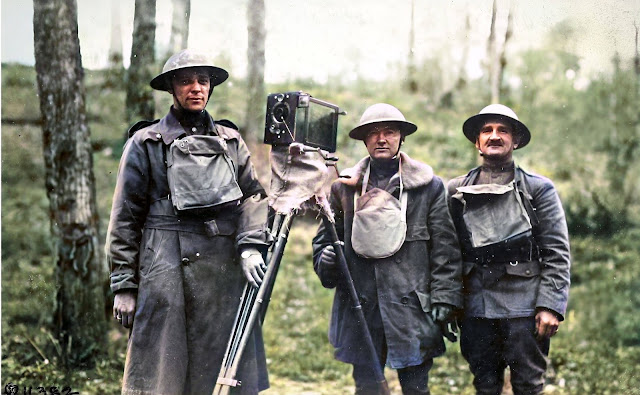Edgar B. Hatrick (left) on the Western Front near Sommedieue, France, April 1918. In the middle: Sergeant Adrian C. Duff, U.S. Signal Corps. Colorized photo from the U.S. Signal Corps Collection, National ArchivesLink to original high res image |
 |
Opening scene America's Answer (1918) |
First Showing in Paris
An intriguing story about America's Answer has never been told before: the movie was first shown in France, not in the U.S.A. It was first exhibited at the Gaumont Palace in Paris on June 26, 1918, to a a special audience including Field Marshal Joffre as well as the British and American ambassador. The man who was very much instrumental in producing this movie also hasn't been mentioned before: Edgar B. Hatrick, head of Hearst's I.N.S. photo and newsreel service. In April 1918, the CPI sent Hatrick to France to report on the motion picture coverage of the war by the U.S. Signal Corps. His film work in France has been described in more detail in our book American Cinematographers in the Great War.According to this trade paper report in Moving Picture World, Hatrick was sent to Europe as a special representative of George Creel, chairman of the Committee on Public Information, America's wartime propaganda agency. He was given a six months leave of absence by his chief William Randolph Hearst. While supervising the production of war films, Hatrick was accompanied by cinematographer C..J. Hubbell. During this time in France Hatrick also reportedly supervised principal photography for America's Answer.
Here is Hatrick's own story about making this movie, as published in the trade paper Moving Picture World of August 17, 1918 and in the Washington News, September 1918.
Footage from America's Answer is hard to find on the Internet. The Imperial War Museum has four reels of a British version online, and although a good copy it isn't the complete movie as shown on the screen in 1918. The authors found an original print in the files of the National Archives in College Park, MD, and we uploaded all nine reels of this historic movie on America's involvement in World War I.
After almost one hundred years the film is now in the public domain and available to all on the Internet.




